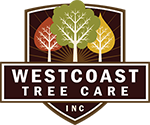When people refer to environmental hazards, they often think about weather-related dangers like floods, storms, etc. However, the weather is only part of what causes less thought about dangers like falling trees.
While trees provide us with significant benefits, they can also cause severe damage or harm if they aren’t taken care of. Examples include fallen branches or entire trees on homes, cars, power lines, and people. Fortunately, there are some Portland tree care signs to look out for that show these imminent dangers. That’s why the ISA certified arborist at Westcoast Tree Care suggests inspecting your trees for the following hazardous signs.
Portland Tree Care
Topped Trees
Topped trees (the top is cut off) present hazardous dangers in several ways. Not only are topped trees more susceptible to disease and insect infestations, but they are also top-heavy, which weakens their structural integrity due to excessive regrowth and weakly attached branches.
Dead Tree (Or) Branches
One of the most dangerous things to look out for is a dead tree or dead branches. Why? They can fall unexpectedly at any time, crushing whatever is below them. That’s why it’s particularly important to pay attention to your trees after stormy weather when branches may have broken, or a tree develops a sudden lean.
Insects & Disease
Disease and insect infestations can lead to serious tree hazards. While a Portland tree care professional is better suited for identifying these problems, an attentive homeowner can notice certain things.
While some diseases like internal like rot and decay are invisible to the naked eye, there is evidence to look out for, like the presence of mushrooms around the base of a tree. Other times, you can see rotted wood or open cavities. While not every hole is a hazardous risk, it’s important to have a tree inspected by a certified arborist to ensure its structural integrity.
Growth Patterns
Even the natural growth of a tree can spell trouble. For example, codominant trunks or branches can become a problem. Codominant areas can form “included bark” which forms between two trunks or branches. This, in turn, weakens the area where they come together, increasing the risk of splitting.
Westcoast Tree Care
While this post doesn’t include every hazardous sign to look out for, you can start recognizing many of the warning signs and know when to call a certified arborist. Doing so will reduce any risks to your home, property, and family. For more information and to get a no-cost, no-obligation quote, contact Westcoast Tree Care by filling out our online form or give us a call at 1.800.767.8733 today.








